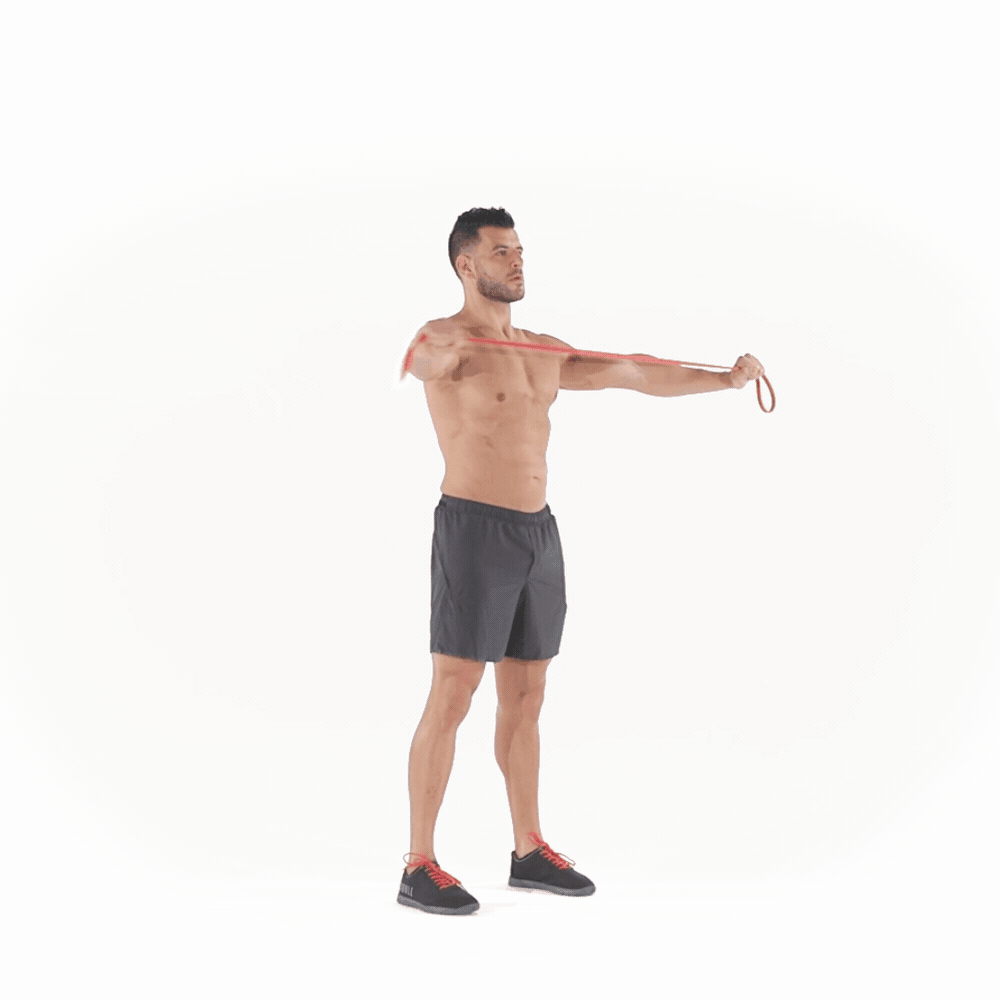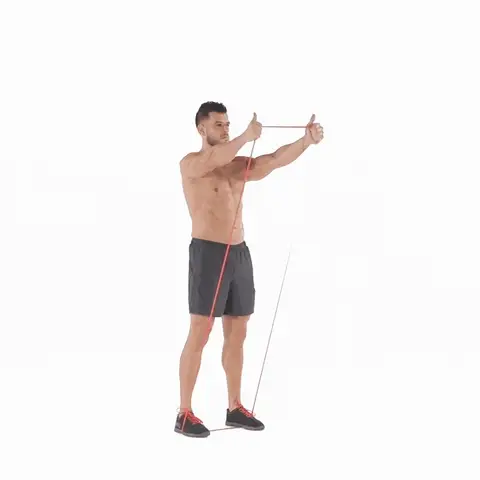Dive into the multifaceted advantages of resistance bands, which extend beyond muscle building to include the alleviation of joint discomfort. Despite their compact size, these bands are remarkably travel-friendly, offering a convenient option for maintaining your strength training routine while on the move. Available in an array of resistance levels and styles, they present a cost-effective substitute for conventional weights, all while delivering outcomes akin to those achieved with traditional gym equipment. Whether you’re just starting your fitness journey or have been at it for years, resistance bands provide a versatile toolkit for enhancing strength and overall well-being, adaptable to any setting and schedule.
Benefits of Exercise Bands
1. No Gym, No Problem: Crush Your Workout From Anywhere!
Resistance bands offer numerous advantages, one of which is their affordability. They provide a cost-effective alternative for individuals unable to afford a gym membership, with prices starting as low as $15. These bands offer diverse resistance levels, comparable to handheld weights, making them an accessible option for effective strength training. Additionally, numerous apps offer daily workout routines tailored for resistance bands, enhancing accessibility and convenience for users.

2. Build Muscle Anywhere: The Power of Resistance Bands
While resistance bands are often perceived as beginner-friendly, they can effectively challenge even the most advanced fitness enthusiasts when utilized correctly. Surprisingly versatile, these bands offer substantial benefits for individuals of all fitness levels. Research on healthy women utilizing resistance bands revealed significant improvements in overall fitness, including muscular strength, endurance, and cardiovascular health. With the right selection and proper technique, resistance bands prove to be a formidable tool for enhancing fitness across the board.
3. Support Your Recovery: Resistance Bands for Knee Osteoarthritis
Resistance training has a rich history within physical therapy settings, particularly for at-home exercises complementing in-office sessions. Specifically, resistance bands offer a convenient option for strengthening exercises, especially for individuals seeking to enhance knee stability. A study published in the Journal of Sports Science & Medicine investigated the efficacy of a home-based rehabilitation program utilizing resistance bands for individuals with knee osteoarthritis, a degenerative joint condition. Participants reported notable improvements in knee stability and functionality, indicating the potential of resistance band training to enhance overall quality of life for those with knee osteoarthritis.
4. Improve Hip Mobility with Resistance Bands
Researchers conducted studies utilizing two exercises known as monster walks and sumo walks to assess the effectiveness of exercise bands in hip rehabilitation. These exercises involved placing resistance bands around the knees, ankles, and feet, with the resistance adjusted for measurement purposes. The findings demonstrated significant enhancement in hip functionality, particularly through strengthening the gluteal muscle group. Such exercises utilizing band resistance present promising solutions for individuals experiencing hip and back issues, potentially offering relief and improved mobility.
Resistance Bands Workout
Diversify your fitness routine with versatile resistance band workouts that can be done anywhere. Tailored for all levels, follow the recommended sets based on your expertise. After each set, take a brief 10 to 15-second rest before repeating. For novices, complete two sets of eight repetitions using the lightest resistance band. If you’re seeking more intensity, adjust your positioning on the band or opt for a higher resistance level.
Intermediates should aim for three sets of 12, selecting a band of moderate resistance. For those at an advanced level, challenge yourself with heavier resistance bands or utilize both medium and heavy options. Execute three sets of 20 repetitions per exercise for a comprehensive workout experience.
1. Bicep Curls
How to Perform:
- Position yourself securely on the resistance band, ensuring it’s under your feet.
- Grasp the handles with your palms facing upward.
- Engage your core and maintain a slight bend in your knees.
- Keep your feet hip-width apart for stability.
- With elbows close to your sides, slowly curl your arms upward.
- Bring the palms toward your shoulders in a controlled motion resembling a bicep curl.
- Return to the starting position with control, resisting the band’s pull.
- Maximize muscle engagement by controlling the movement.
- To increase tension, either select a band with higher resistance or adjust your stance by widening your feet.

2. BANDED TRICEP PULL-APARTS
How to Perform:
- Stand tall and hold your resistance band in both hands.
- Keep it parallel to the floor at shoulder height.
- Position each hand near the end, and make sure the band is taut but not stretched out yet. This should be slightly wider than your shoulders.
- Keep your arms parallel to the floor, bend at the elbows, and have your palms facing the floor.
- Keeping your hands steady at shoulder height, pull the ends of the band away from each other by straightening your arms and flexing your triceps.
- Pause and squeeze the muscles, and then return to the start position.
- Do these for 3 sets of 15-20 reps as one of your last exercises.

3. Upright Rows
How to Perform:
- Stand with feet hip-width apart, positioning yourself at the center of the resistance tube.
- Cross the tube once in front of you to add tension. For increased tension, widen your stance or cross the bands twice.
- Keep your arms down at your sides.
- When ready, raise the handles toward your chin while keeping your arms close to your body.
- Allow the handles to touch during the movement to maintain proper form.
- Slowly lower back down with control.
- Repeat the exercise for the desired number of repetitions.

4. Wood Chop
How to Perform:
- Begin by securely wrapping the resistance band around your right foot.
- Grasp the other end of the band with both hands at your right hip.
- Rotate your hips, legs, and torso to the left, initiating the twist.
- Simultaneously extend your arms and press the handle overhead and in front of you to full extension.
- Maintain control throughout the movement to maximize muscle engagement.
- Reverse the steps to return to the starting position.
- Complete all repetitions on one side before switching to the other side.

5. Lunges
How to Perform:
- Stand with your right foot in the middle of the resistance band and hold the handles in each hand.
- Position your left leg back into a lunge stance, knees forming 90-degree angles.
- Perform a lunge by bending both knees, keeping tension on the band.
- Simultaneously, halfway curl your elbows, bringing the handles toward your shoulders.
- Push through your right heel to return to the starting position, extending your legs and arms.
- Complete the designated number of reps for each leg with controlled movements.

Conclusion
Resistance bands are an invaluable addition to any fitness routine, offering versatility, portability, and effectiveness in building strength and enhancing overall well-being. Their ability to provide a full-body workout with minimal equipment makes them ideal for those who want to maintain a fitness regimen without the constraints of traditional gym settings. Whether you’re using them to support recovery from an injury, enhance your muscle-building efforts, or simply add variety to your workouts, resistance bands can help you achieve your fitness goals efficiently. Embrace these bands as a staple in your fitness toolkit, and enjoy the benefits of a stronger, more resilient body no matter where your journey takes you.